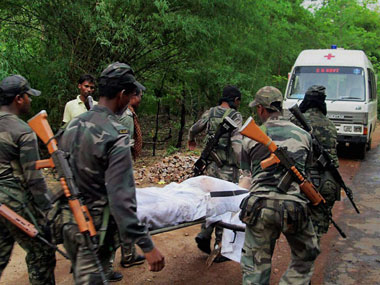The deadly attack on top politicians in Chhattisgarh on 25 May has served as a chilling realisation for politicians that they are a frontline target for Maoists. And with the realisation seems to have come ready consensus for a forceful response to counter the left-wing extremists. According to sources in the government, chief ministers of the nine Maoist-affected states have agreed to come up with a uniform response to left-wing extremism and to deal with it as a policing issue first. [caption id=“attachment_856469” align=“alignleft” width=“380”]  PTI[/caption] The centre is set to increase troop levels in the counter-naxal operations by 30 battalions over the next three years, say government sources. (Presently there are 81 battalions of Central Armed Police Forces spread across the naxal-affected states of Chhattisgarh, Jharkhand, Bihar, Odisha, West Bengal, Maharashtra, Uttar Pradesh, Madhya Pradesh and Andhra Pradesh). The additional forces will fill up ’empty spaces’ (areas where there are no paramilitary bases) in the ‘severely Maoist-affected’ states of Chhattisgarh, Jharkhand and Odisha in order to make special operations into Naxal strongholds possible. Towards gaining proximity and accessibility into pockets that are dominated by the armed rebels, the centrally-funded road requirement plan is expected to become more flexible with the Home Ministry delegating more powers to the state governments. A decision to that effect was taken at the special session of CMs of Naxal-affected states on 5 June, say government sources. Setting camps closer to the Maoist strongholds and increasing road connectivity in a big way will be part of the strategy towards increasing mobility of the troops. Sources in the government concede that in areas where the Maoists are strong, the levels and nature of deployment of central forces is weak and dispersed. The central schemes for modernisation of police forces and the setting up of fortified police stations don’t seem to have made the desired progress with Chhattisgarh and Jharkhand showing ‘very poor’ and ’not-so-good’ ulitisation of funds. Prior to the 25 May attack that killed 27 people, the Naxal-related violence and deaths has been on the downswing since 2010. While security experts have called the falling figures deceptive, the Ministry of Home Affairs maintains that it is a result of loss of senior cadres, arrest, desertion and general demoralization. As per the Ministry’s assessment, the Maoists have contracted but consolidated in pockets.
The deadly attack on top Chhattisgarh politicians in Chhattisgarh on 25 May has served as a chilling realisation for politicians that they are a frontline target for Maoists.
Advertisement
End of Article


)

)
)
)
)
)
)
)
)



